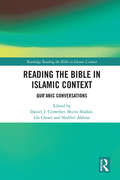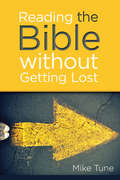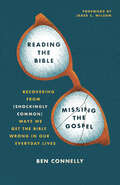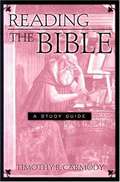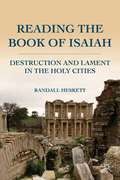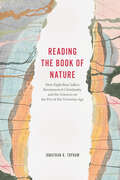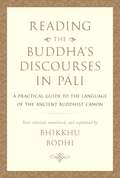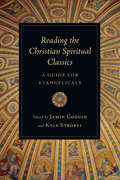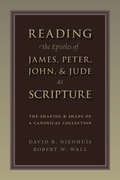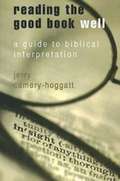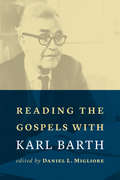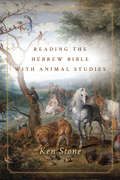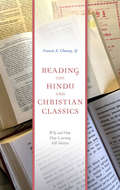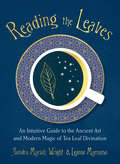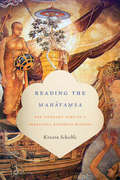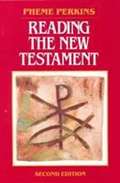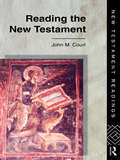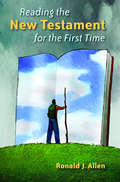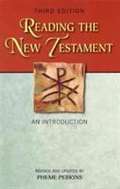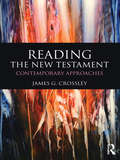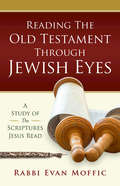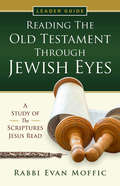- Table View
- List View
Reading the Bible in Islamic Context: Qur'anic Conversations (Routledge Reading the Bible in Islamic Context Series)
by Shirin Shafaie Shabbir Akhtar Daniel J Crowther Ida GlaserIn the current political and social climate, there is increasing demand for a deeper understanding of Muslims, the Qur’an and Islam, as well as a keen demand among Muslim scholars to explore ways of engaging with Christians theologically, culturally, and socially. This book explores the ways in which an awareness of Islam and the Qur’an can change the way in which the Bible is read. The contributors come from both Muslim and Christian backgrounds, bring various levels of commitment to the Qur’an and the Bible as Scripture, and often have significantly different perspectives. The first section of the book contains chapters that compare the report of an event in the Bible with a report of the same event in the Qur’an. The second section addresses Muslim readings of the Bible and biblical tradition and looks at how Muslims might regard the Bible - Can they recognise it as Scripture? If so, what does that mean, and how does it relate to the Qur’an as Scripture? Similarly, how might Christian readers regard the Qur’an? The final section explores different analogies for understanding the Bible in relation to the Qur’an. The book concludes with a reflection upon the particular challenges that await Muslim scholars who seek to respond to Jewish and Christian understandings of the Jewish and Christian scriptures. A pioneering venture into intertextual reading, this book has important implications for relationships between Christians and Muslims. It will be of significant value to scholars of both Biblical and Qur’anic Studies, as well as any Muslim seeking to deepen their understanding of the Bible, and any Christian looking to transform the way in which they read the Bible.
Reading the Bible without Getting Lost
by Mike Tune"Scripture did not spring from the imaginations of ancient men, but holy men spoke and wrote as they were carried along by the Spirit of God" (2 Pet. 1:21). This simple handbook serves as a guide to help beginning readers of the Bible arrive where the Spirit intended.The Bible is a vast library of writings spanning centuries and cultures. It can be daunting and confusing for inexperienced Bible readers. Reading the Bible without Getting Lost gets to the heart of every book of the Bible and provides a reader's roadmap through each one. In addition, it provides an overview of the biblical story, a brief treatment of types of literature in the Bible, and a simple guide to studying the Bible.There are many books on biblical interpretation and many hefty introductions to the Bible, but this book joins the two into a manageable size and simple presentation for beginning Bible students.
Reading the Bible, Missing the Gospel: Recovering from (Shockingly Common) Ways We Get the Bible Wrong in our Everyday Lives
by Ben ConnellyDon&’t keep asking God for forgiveness. Do judge one another. And you&’re not going to heaven for all eternity!How have we misunderstood the teachings of Jesus? Often His message to the leaders and disciples was: You&’re getting this wrong! Somewhere along the way you got confused, lost, way off track. Would He have the same assessment of us today?In Reading the Bible, Missing the Gospel, pastor and author Ben Connelly shows us how to recover God&’s original intentions in light of the story of redemption. Connelly helps us celebrate and understand how Jesus&’ life, death, and resurrection are truly good news for the tangible situations in our everyday lives. Biblical misunderstandings can lead to a small view of God—but truth overturns that. It expands our hearts for God and enables us to truly love others! Using theology, humor, and practical examples the author reveals shockingly common ways we get the Bible wrong. Connelly invites Christians to see themes and teachings with new eyes—or, rather, with old eyes—on topics like confession and forgiveness . . . what it means to be blessed or happy . . . whether we&’re commanded to or prohibited from passing judgement. How does the gospel inform our understanding and answer these questions? Connelly gives readers a new gospel-focused lens that addresses common frustrations and helps them see with renewed hope, clarity, and courage.
Reading the Bible, Missing the Gospel: Recovering from (Shockingly Common) Ways We Get the Bible Wrong in our Everyday Lives
by Ben ConnellyDon&’t keep asking God for forgiveness. Do judge one another. And you&’re not going to heaven for all eternity!How have we misunderstood the teachings of Jesus? Often His message to the leaders and disciples was: You&’re getting this wrong! Somewhere along the way you got confused, lost, way off track. Would He have the same assessment of us today?In Reading the Bible, Missing the Gospel, pastor and author Ben Connelly shows us how to recover God&’s original intentions in light of the story of redemption. Connelly helps us celebrate and understand how Jesus&’ life, death, and resurrection are truly good news for the tangible situations in our everyday lives. Biblical misunderstandings can lead to a small view of God—but truth overturns that. It expands our hearts for God and enables us to truly love others! Using theology, humor, and practical examples the author reveals shockingly common ways we get the Bible wrong. Connelly invites Christians to see themes and teachings with new eyes—or, rather, with old eyes—on topics like confession and forgiveness . . . what it means to be blessed or happy . . . whether we&’re commanded to or prohibited from passing judgement. How does the gospel inform our understanding and answer these questions? Connelly gives readers a new gospel-focused lens that addresses common frustrations and helps them see with renewed hope, clarity, and courage.
Reading the Bible: A Study Guide
by Timothy R. Carmody<P>An engaging biblical text in order to better understand and interpret it, and to enter into the process of learning how to do this.<P> Ideal for introductory Bible courses, adult education groups, and readers of any faith.
Reading the Book of Isaiah
by Randall HeskettRandall Heskett uses both historical criticism and a form-critical approach to analyze and assess Lamentation and Restoration of Destroyed Cities as oral traditions of ancient Israelite prophetic genres.
Reading the Book of Nature: How Eight Best Sellers Reconnected Christianity and the Sciences on the Eve of the Victorian Age
by Jonathan R. TophamA powerful reimagining of the world in which a young Charles Darwin developed his theory of evolution. When Charles Darwin returned to Britain from the Beagle voyage in 1836, the most talked-about scientific books of the day were the Bridgewater Treatises. This series of eight works was funded by a bequest of the last Earl of Bridgewater and written by leading men of science appointed by the president of the Royal Society to explore "the Power, Wisdom, and Goodness of God, as manifested in the Creation." Securing public attention beyond all expectations, the series offered Darwin’s generation a range of approaches to one of the great questions of the age: how to incorporate the newly emerging disciplinary sciences into Britain’s overwhelmingly Christian culture. Drawing on a wealth of archival and published sources, including many unexplored by historians, Jonathan R. Topham examines how and to what extent the series contributed to a sense of congruence between Christianity and the sciences in the generation before the fabled Victorian conflict between science and religion. Building on the distinctive insights of book history and paying close attention to the production, circulation, and use of the books, Topham offers new perspectives on early Victorian science and the subject of science and religion as a whole.
Reading the Book of Nature: How Eight Best Sellers Reconnected Christianity and the Sciences on the Eve of the Victorian Age
by Jonathan R. TophamA powerful reimagining of the world in which a young Charles Darwin developed his theory of evolution. When Charles Darwin returned to Britain from the Beagle voyage in 1836, the most talked-about scientific books of the day were the Bridgewater Treatises. This series of eight works was funded by a bequest of the last Earl of Bridgewater and written by leading men of science appointed by the president of the Royal Society to explore "the Power, Wisdom, and Goodness of God, as manifested in the Creation." Securing public attention beyond all expectations, the series offered Darwin’s generation a range of approaches to one of the great questions of the age: how to incorporate the newly emerging disciplinary sciences into Britain’s overwhelmingly Christian culture. Drawing on a wealth of archival and published sources, including many unexplored by historians, Jonathan R. Topham examines how and to what extent the series contributed to a sense of congruence between Christianity and the sciences in the generation before the fabled Victorian conflict between science and religion. Building on the distinctive insights of book history and paying close attention to the production, circulation, and use of the books, Topham offers new perspectives on early Victorian science and the subject of science and religion as a whole.
Reading the Buddha's Discourses in Pali: A Practical Guide to the Language of the Ancient Buddhist Canon
by Bhikkhu BodhiRenowned scholar-monk and bestselling translator Bhikkhu Bodhi&’s definitive, practical guide on how to read ancient Buddhist texts in the original language.Bhikkhu Bodhi&’s sophisticated and practical instructions on how to read the Pali of the Buddha&’s discourses will acquaint students of Early Buddhism with the language and idiom of these sacred texts. Here the renowned English translator of the Pali Canon opens a window into key suttas from the Sa?yutta Nikaya, giving a literal translation of each sentence followed by a more natural English rendering, then explaining the grammatical forms involved. In this way, students can determine the meaning of each word and phrase and gain an intimate familiarity with the distinctive style of the Pali suttas—with the words, and world, of the earliest Buddhist texts. Ven. Bodhi&’s meticulously selected anthology of suttas provides a systematic overview of the Buddha&’s teachings, mirroring the four noble truths, the most concise formulation of the Buddha&’s guide to liberation. Reading the Buddha&’s Discourses in Pali shares with readers not only exceptional language instruction but also a nuanced study of the substance, style, and method of the early Buddhist discourses.
Reading the Christian Spiritual Classics: A Guide for Evangelicals
by Jamin Goggin Kyle C. StrobelCelebration of Disciplinewhywhathow
Reading the Epistles of James, Peter, John & Jude as Scripture: The Shaping and Shape of a Canonical Collection
by Robert W. Wall David NienhuisThrough a detailed examination of the historical shaping and final canonical shape of seven oft-neglected New Testament letters, Reading the Epistles of James, Peter, John, and Jude as Scripture introduces readers to the historical, literary, and theological integrity of this indispensable apostolic witness.While most scholars today interpret biblical texts in terms of their individual historical points of composition, David Nienhuis and Robert Wall argue that a theological approach to this part of Scripture is better served by attending to these texts' historical point of canonization -- those key moments in the ancient church's life when apostolic writings were grouped together to maximize the Spirit's communication of the apostolic rule of faith to believers everywhere.Reading the Epistles of James, Peter, John, and Jude as Scripture is the only treatment of the Catholic Epistles that approaches these seven letters as an intentionally designed and theologically coherent canonical collection.
Reading the Good Book Well: A Guide to Biblical Interpretation
by Jerry Camery-HoggattThe state of teaching biblical interpretation in colleges and seminaries is generally a mess, and many conventional approaches can be alarming for religious students. The sources of this difficulty are wide ranging, but a quick summary would include at least the following: jargon that is unnecessarily technical; competing and contradictory methodologies; and a failure on the part of Biblical scholarship to demonstrate the direct relevance of its methods to the pastoral life of the Church. As a consequence, biblical scholarship is often opaque at best and distressing at worst to the student and beginning theologian. And because pastors and lay people are trained within this cobweb of methods, they are often functionally unable to draw clear conclusions from most teaching resources. Jerry Camery-Hoggatt addresses this problem with several solutions: a return to a conscious affirmation of authorial intention as the beginning place for interpretation; a careful examination of the actual workings of communication; a concept of text to include the assumptions and cultural knowledge upon which the text depends for meaningful communication; an examination of the various academic disciplines with an eye toward correlating their conclusions with the necessary activities of reading; and easily accessible language that makes sense to the beginning student and the lay reader alike. Here is a single, accessible volume that explains the basic vocabulary and logic of biblical interpretation, shows how the various methodologies can be fitted together into a seamless interpretive model for exegesis, and then reflects carefully on the implications of that method for the various issues of reading, teaching, reflection, and preaching.Through common and practical examples Jerry Camery-Hoggatt teaches students a way of reading the Bible that replicates the activities the biblical authors expected their readers would perform, and he uses a model that is applicable across linguistic boundaries, genres, and various cultural contexts; that is, throughout the human experience of language there exists a common set of mental activities that can be identified and studied, and these are fundamental to reading and interpreting the Bible.The prose style is conversational, non-technical, and is intended to be inviting to the beginning student, and refreshing for advanced students and teachers.
Reading the Gospels with Karl Barth
by Daniel L. MiglioreOver the course of his multivolume Church Dogmatics, Karl Barth not only cites thousands of Scripture texts but also offers extensive exegetical discussion of numerous passages. In this book twelve leading theologians and biblical scholars examine Barth's exegesis of particular passages in the Gospels. How does Barth's practice of theological exegesis play out in his reading of the Gospels? What are the fundamental features of Barth's interpretation of Gospel texts, and to what extent do they enliven theology, biblical studies, and ethics today? Reading the Gospels with Karl Barth explores answers to such questions and offers fresh stimulus for further study and discussion.CONTRIBUTORS Richard Bauckham Kendall Cox Beverly Roberts Gaventa Eric Gregory Willie James Jennings Paul Dafydd Jones Bruce L. McCormack Daniel L. Migliore Jürgen Moltmann Paul T. Nimmo Fleming Rutledge Shannon Nicole Smythe
Reading the Hebrew Bible with Animal Studies
by Ken StoneAnimal studies may be a recent academic development, but our fascination with animals is nothing new. Surviving cave paintings are of animal forms, and closer to us, as Ken Stone points out, animals populate biblical literature from beginning to end. This book explores the significance of animal studies for the interpretation of the Hebrew Bible. The field has had relatively little impact on biblical interpretation to date, but combined with biblical scholarship, it sheds useful light on animals, animal symbolism, and the relations among animals, humans, and God—not only for those who study biblical literature and its ancient context, but for contemporary readers concerned with environmental, social, and animal ethics. Without the presence of domesticated and wild animals, neither biblical traditions nor the religions that make use of the Bible would exist in their current forms. Although parts of the Bible draw a clear line between humans and animals, other passages complicate that line in multiple ways and challenge our assumptions about the roles animals play therein. Engaging influential thinkers, including Jacques Derrida, Donna Haraway, and other experts in animal and ecological studies, Reading the Hebrew Bible with Animal Studies shows how prehumanist texts reveal unexpectedly relevant dynamics and themes for our posthumanist age.
Reading the Hindu and Christian Classics: Why and How Deep Learning Still Matters (Richard Lectures)
by Francis X. ClooneyWe live in an era of unprecedented growth in knowledge. Never before has there been so great an availability of and access to information in both print and online. Yet as opportunities to educate ourselves have greatly increased, our time for reading has significantly diminished. And when we do read, we rarely have the patience to read in the slow, sustained fashion that great books require if we are to be truly transformed by them. In Reading the Hindu and Christian Classics, renowned Harvard Divinity School professor Francis Clooney argues that our increasing inability to read in a concerted manner is particularly notable in the realm of religion, where the proliferation of information detracts from the learning of practices that require slow and patient reading. Although awareness of the world’s many religions is at an all-time high, deep knowledge of the various traditions has suffered. Clooney challenges this trend by considering six classic Hindu and Christian texts dealing with ritual and law, catechesis and doctrine, and devotion and religious participation, showing how, in distinctive ways, such texts instruct, teach truth, and draw willing readers to participate in the realities they are learning. Through readings of these seminal scriptural and theological texts, he reveals the rewards of a more spiritually transformative mode of reading—and how individuals and communities can achieve it.
Reading the Leaves: An Intuitive Guide to the Ancient Art and Modern Magic of Tea Leaf Divination
by Sandra Mariah Wright Leanne MarramaAn illustrated guide to tapping into your intuition through the simple act of sitting down to a cup of tea.Whether you're wondering about career, finances, love, or health, Salem witches Sandra Mariah Wright and Leanne Marrama are here to help build your intuitive skills and transform your life. Reading the Leaves shows you how to: • brew a cup of tea for divination purposes • interpret more than 200 time-tested symbols that are most likely to show up, such as hearts and anchors, and what their size, location, and relationship to other shapes mean • set an intention • create a regular tea ritual • keep a tea leaf reading journal • do a reading for family and friends • make their favorite tea time recipes • respond when a "bad" symbol shows upYou already possess the tools, and with Sandra and Leanne's guidance, the true journey of self-discovery can begin. You don't have to be a witch to find your inner magic.
Reading the Mahāvamsa: The Literary Aims of a Theravada Buddhist History (South Asia Across the Disciplines)
by Kristin ScheibleVamsa is a dynamic genre of Buddhist history filled with otherworldly characters and the exploits of real-life heroes. These narratives collapse the temporal distance between Buddha and the reader, building an emotionally resonant connection with an outsized religious figure and a longed-for past. The fifth-century Pali text Mahavamsa is a particularly effective example, using metaphor and other rhetorical devices to ethically transform readers, to stimulate and then to calm them. Reading the Mahavamsa advocates a new, literary approach to this text by revealing its embedded reading advice (to experience samvega and pasada) and affective work of metaphors (the Buddha's dharma as light) and salient characters (nagas). Kristin Scheible argues that the Mahavamsa requires a particular kind of reading. In the text's proem, special instructions draw readers to the metaphor of light and the nagas, or salient snake-beings, of the first chapter. Nagas are both model worshippers and unworthy hoarders of Buddha's relics. As nonhuman agents, they challenge political and historicist readings of the text. Scheible sees these slippery characters and the narrative's potent and playful metaphors as techniques for refocusing the reader's attention on the text's emotional aims. Her work explains the Mahavamsa's central motivational role in contemporary Sri Lankan Buddhist and nationalist circles. It also speaks broadly to strategies of reading religious texts and to the internal and external cues that give such works lives beyond the page.
Reading the Muslim Mind
by Hassan HathoutOnce in a while a book comes along that can reshape the thinking of the world. One person at a time. Reading the Muslim Mind is such a book. Dr. Hassan Hathout starts out from a simple observation a lifetime of biculturalism (the Egyptian-born physician initially resided in Britain and has lived in the U.S. for more than a decade) leads him to note that Islam is widely known in the West for what it is not.<P> This encyclopedic personality (doctor of medicine, thinker, speaker, poet) sets out to guide the reader on a comprehensive tour through Islam. For this voyage, he supplies a keen and lucid anatomy of the Islamic life. He also provides, with incisive clarity, the inner guidebook; he uncovers the tracing of the mind at work behind the practice, the spirit behind the letter, the rationale and the Ultimate Reason, God.<P> For non-Muslims and those who follow what Dr. Hathout aptly calls the Judeo-Christian-Islamic world tradition at large, the trip proves illuminating and thought-provoking. For Muslims, it will re-anchor their faith and offer vital and timely answers to up-to-the-minute dilemmas of life in the new millennium.<P> Reading the Muslim Mind addresses key issues of our time, from the Islamic perspective. Dr. Hathout, in this wise, warm and inspiring work, is speaking to the audience of humankind in the Age of Selfishness, Microtheism, and Godlessness. In his clarion call of hope, the author maintains that when a minimum critical mass turns to understanding and cooperation, real change is possible.<P> To be known for what one really is, is nothing less than a basic human right, Dr. Hathout notes. Here, then, is Islam as it really is, and the world as it really can be.
Reading the New Testament
by Pheme PerkinsA complete revision of the first edition, includes additional chapters on individual books of the New Testament; information from archaeology and social history that has come to light in the past decade.
Reading the New Testament (New Testament Readings)
by John CourtReading the New Testament is the lead volume to the successful New Testament Readings Series. It analyzes the many ways in which the New Testament can be read and interpreted.Rather than prescribing one 'correct' way of reading, this study offers an overview of and introduction to the most influential theories of recent scholarship, discussing the background against which such theories are developed. It shows the advantages of combining methods of reading, thus stimulating an interaction between various approaches, illustrated by the individual volumes in the series.This is an important addition to New Testament literature, offering the student of religion a comprehensive overview of the methods and approaches used by scholars in the field.
Reading the New Testament for the First Time
by Ronald J. AllenThe purpose of this book is to introduce the New Testament to those who have never read it. Ronald Allen offers a truly elementary guide to the New Testament's world, its story, and its message. Reading the New Testament for the First Time walks readers through the New Testament, covering key topics like these: how to find one's way around the New Testamenthow and when the New Testament was writtenimportant characters like Jesus, Paul, and the twelve disciplesbig ideas found in the New Testament such as love, righteousness, and the realm of Godhow to apply the New Testament to our lives todayand much more!
Reading the New Testament: An Introduction (Third Revised Edition)
by Pheme Perkins Frank SabbatéAn introduction to the writings of the New Testament, written by a prominent scholar who is able to communicate the main ideas and results with a clear and simple style. This third edition, although leaving intact the structure of the book, has been rewritten extensively, updating the information and adding the results of new biblical approaches and research. Includes new maps and illustrations.
Reading the New Testament: Contemporary Approaches
by James G. CrossleyReading the New Testament offers an exciting and contemporary approach to New Testament Studies, which have changed dramatically in the past thirty years. James Crossley combines an introduction to traditional methods of source, form and social-scientific criticism with postcolonial, gender and political frameworks. He discusses reception-history, covering areas such as popular culture, party politics, historical theology and the politics of contemporary scholarship. He discusses Paul and Christian origins in continental philosophy, as well as offering a more traditional analysis of Paul’s theology and the quest for the historical Jesus. A selection of readings from contemporary scholarship is provided in the final chapter of the book. Reading the New Testament has been carefully designed to help students think critically and in wide-ranging ways about the texts of the New Testament and will prove a valuable resource for everyone engaged in serious study of the Bible.
Reading the Old Testament Through Jewish Eyes (Reading the Old Testament Through Jewish Eyes)
by Evan MofficRabbi Evan Moffic has a passion for sharing Judaism and its traditions with Christian audiences.In Reading the Old Testament Through Jewish Eyes, Rabbi Moffic explores the Torah, the first five books of the Hebrew Bible, and highlights points of interest to Christians. He describes the role of the Torah in Jewish worship and practice and explores the key themes of each book guided by the wisdom of Jewish interpreters through the centuries. Join Rabbi Moffic in this study of the Torah and find rich new insights into the biblical story. Discover how the Torah can be a source of wisdom, truth, and transformation in your life.Also available are a DVD and Leader Guide to facilitate a six-week study.
Reading the Old Testament Through Jewish Eyes Leader Guide (Reading the Old Testament Through Jewish Eyes)
by Evan MofficRabbi Evan Moffic has a passion for sharing Judaism and its traditions with Christian audiences.In Reading the Old Testament Through Jewish Eyes, Rabbi Moffic explores the Torah, the first five books of the Hebrew Bible, and highlights points of interest to Christians. He describes the role of the Torah in Jewish worship and practice and explores the key themes of each book guided by the wisdom of Jewish interpreters through the centuries. Join Rabbi Moffic in this study of the Torah and find rich new insights into the biblical story. Discover how the Torah can be a source of wisdom, truth, and transformation in your life.Also available are a book and DVD to facilitate a six-week study.
